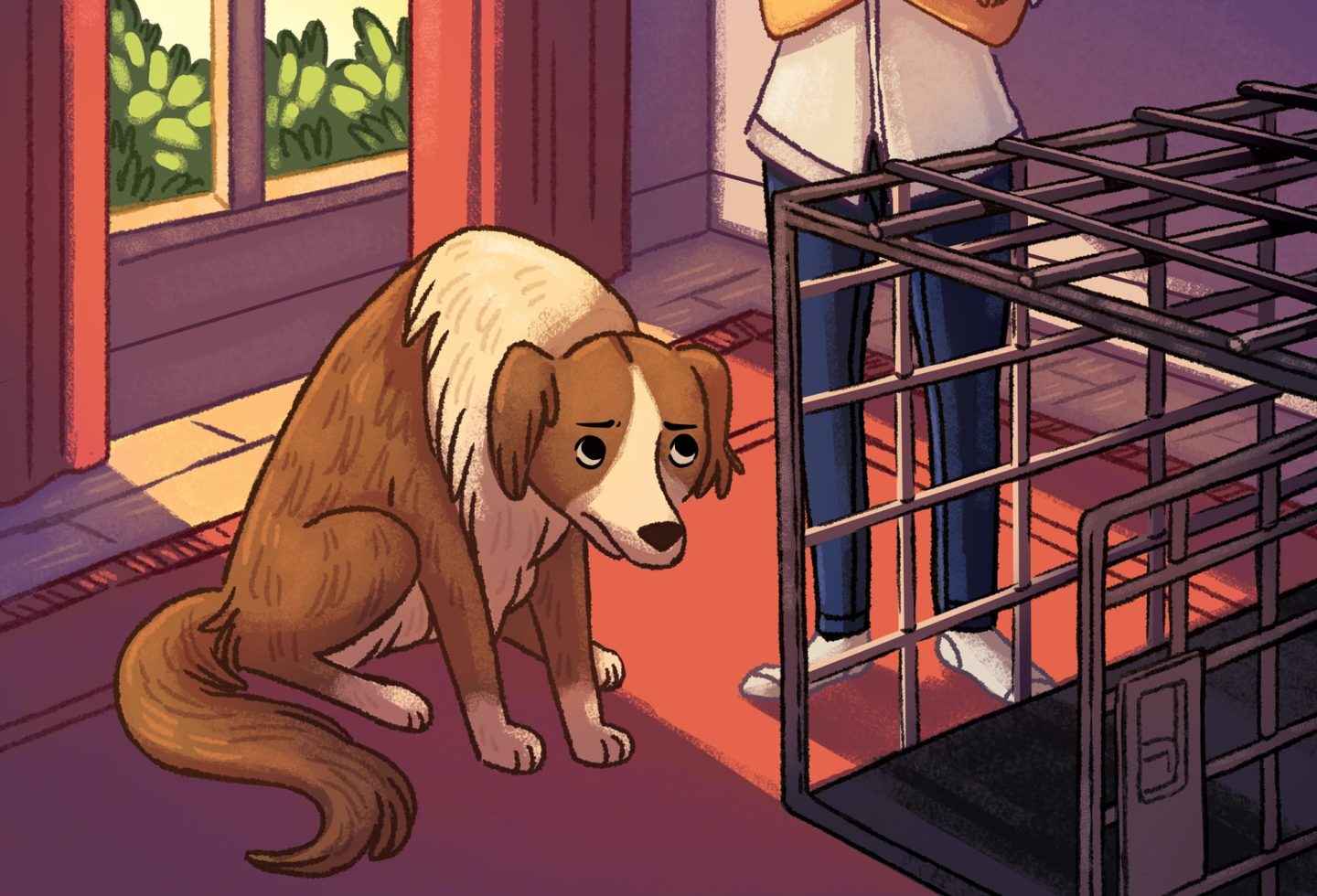

Do We Crate Too Much?
Rethinking how and why we crate dogs
Crates are a normal part of life for many North American dogs, often used during potty training and even through adulthood when guardians are at work. But did you know in some parts of Europe crating dogs in the home is actually illegal?
During my journey as a trainer my use of crates has evolved considerably. In my 20 years of working with dogs, competing and titling in multiple sports, I have been blessed to share my life with many dogs, all of whom I have crate trained. But what dogs have taught me—and what they continue to teach me—is that they are individuals and just because something is accepted as a normalized practice for dogs doesn’t mean it’s ethical or the right decision for all dogs in all situations.
Dogs vs. Wolves
Most justifications for using crates center around the idea that dogs naturally like crates because they are den animals descended from wolves. But as modern dog trainers and dog people, we have evolved our understanding of dogs. We know that dogs are not wolves. We know that anyone who talks about “dominance” and “alpha” or “pack dynamics” is relying on outdated ideas about dogs and dog behaviour and is not someone we want near our dogs. Though wild dogs might sleep in dens, they don’t close each other into locking boxes.
There are valid reasons to crate our dogs, but there isn’t anything natural about it. Khara Schuetzner, MA, CPDT-KSA, CNWI, Chair of The Association of Professional Dog Trainers (APDT) says, “It does not make sense to say ‘den animals.’ [A] possibility for why dogs love crates is the quiet down-time to nap, similar to us going to our bedrooms.”
Though many dog trainers still recommend regularly using crates, concern over how they are used is growing. Jill Breitner, dog trainer and author of the Dog Decoder App would like to see trainers stop using them. “It’s a cage so don’t sugar-coat it,” she says. “When and why do we make it normal to put dogs in cages?” She says that many owners leave their dogs in them for way too long because they don’t have the time or energy to do what it takes to teach house manners and “since they’ve been given the okay by a huge contingency, they feel justified. One can’t teach house manners when they’re locked in a cage. Trainers are doing what they learned without thinking critically about this.”

Illustration by Michelle Simpson
Cultural Differences
Jill isn’t alone in her concerns. Dog crates are much more commonly used in the United States and Canada than they are in other parts of the world. Across much of Europe and in Australia, dog crates don’t tend to be part of the daily life for adult dogs, nor is it common or culturally accepted for dogs to be left in crates for long periods of time. In Finland and Sweden, it is actually illegal to keep dogs crated overnight or while guardians are away at work. In both of these countries there are exceptions made if there is a veterinary reason for a dog to be kept confined while in recovery, or while at a dog show/competition, as well as for travel but dog crates are not a regular part of life for dogs. Eva Bertilsson, dog trainer and owner of Carpe Momentum in Sweden, explains: “In Sweden, we’ve never really had the tradition of crating dogs overnight and definitely not for going to work. Instead, people secure the area where the puppy will be by removing items the puppy should not get to, and/or putting up gates around areas where they don’t want the puppy to have access. It’s the same as with small children—people typically remove move unsuitable items and block access to certain areas.
“We don’t really have a tradition of using playpens for babies either,” Eva continues, also noting that Swedish animal welfare laws regulate living conditions for all animals with requirements for space and comfort. “This cultural backdrop somewhat sets the stage for how dogs are kept and how I work to support dog guardians,” she says.
In Sweden dogs are generally recognized as part of the family and treated culturally much more like children and not left alone for long periods of time.
“Many dogs also go with their owners to work or stay at doggie day care,” Eva explains. “Puppies under four months of age cannot be left alone for more than short periods of time anyway according to law, and, also, with older dogs, there are regulations limiting how long the dog can be left alone. In addition, there seems to be a tradition of reasonable general awareness about the need for gradually teaching dogs to be home alone, just as there is a reasonable general awareness of dogs’ needs for physical and behavioural activities.”
If dogs in other parts of the world with homes and lifestyles similar to our own aren’t being crated, why are North Americans so obsessed with crating our dogs? Unfortunately, I see crates being overused and misused by new and busy pet guardians who are overwhelmed with the responsibility of a dog or puppy.
Potty Training
A primary reason that most people start crate training their dogs as puppies is to aid in potty training. Crate training can be effective and helpful for short periods of time when you can’t supervise a puppy, but they have to be used correctly.
“Crates are useful for house training but only if your puppy’s bladder and bowel capacity are not exceeded,” explains Helen Prinold, M.Sc. Animal Behaviour CPDT-KA, CDBC, Certified Fear Free Professional and Chair of the Canadian Association of Professional Dog Trainers.
It’s important that puppies never be made uncomfortable if crates are part of the potty-training process. “If you have a puppy, you don’t want to leave them in for more than two hours because they are still housetraining,” says Helen. If you aren’t going to be able to get your puppy out to potty every two hours she says, “it’s better to have a crate with a confinement area for a potty break.” This might look like a larger X-pen (essentially a playpen area for dogs), or a room designated as a puppy-safe space that has the crate with the door open for puppies to go in and out, giving the puppy the opportunity to move around freely and play as well as sleep and potty.
This is similar to how puppy training looks in Sweden. “If people have a crate at home, it’s typically used as any other dog bed, functioning as a den with the door open (the door can also be removed altogether). If people need to restrict the dog’s space, gates or play pens or secure rooms are quite commonly used and allow for room to stretch out, move around, and shift between resting areas,” explains Eva.
Crating Tips
- Never crate a puppy for longer than they can hold their bladder. This differs from puppy to puppy but generally for a maximum of 2 hours.
- If necessary, an adult dog experienced and comfortable with being in a crate can be crated longer than a puppy but for no more than four hours.
- If you crate your dog, make it a positive experience by giving chews and stuffed toys like Kongs.
- Never use the crate as punishment.
Destructive Tendencies
Crates are frequently used as management tools for dogs who have a tendency to do damage in the home. Instead, Zazie Todd, PhD author of Wag: The Science of Making Your Dog Happy, recommends having a dog-proof (or puppy-proof) room where you make sure nothing is left out that could harm the dog or cause a problem if they chewed it. This keeps your dog (and your home!) safe while giving your dog freedom to move around while you are away from home and unable to supervise. If you are going to use a crate as part of ongoing management of your adult dog in the home, ethically the time the dog is crated needs to be limited. “Dogs shouldn’t be crated all day. Although there isn’t a hard-and-fast rule for how long a dog should be left in a crate, four hours is a rough maximum,” says Zazie.
“We support graduated transition out of crating in the home and into the dog being comfortable home alone and having free run of the house,” such as being let out in a smaller room unsupervised, notes Helen. This doesn’t mean doing away with crates entirely. Shifting to having a crate with the door open so dogs can self-select versus being forced in can be very helpful.
“A crate with the door always open can become a safe space for your dog to go if they are finding things a bit stressful or just want some peace and quiet. In this case, the crate can be a cozy place to relax, and a place where you won’t disturb them. The dog can go there if the kids are being noisy or there are guests over,” suggests Zazie.
In some instances, limited crate training is the best strategy for the safety of a dog who might chew or eat things they shouldn’t have but it’s important to remember crating a dog doesn’t actually shift a dog’s mental and emotional state. Jill notes that guardians “can’t teach dogs manners, or how to relax on their own if they spend much of the time in a cage. It’s a crutch.” She continues that “dogs are frustrated and/or shut down when left in crates too long.” Essentially when crated your dog is contained but not learning. A dog with separation anxiety that is confined to a crate while their guardian goes to the store might be unable to damage the home, but that doesn’t mean the underlying anxiety has been addressed. In this situation crates are a Band-Aid not a long-term solution. Zazie also urges people crating their dogs to consider whether the dog is getting enough exercise and enrichment. Unfortunately, frequently busy dog guardians use crates as a way to confine their dog instead of adding much needed enrichment and exercise into their dog’s day which could eliminate boredom-based destructive behaviour.

Illustration by Michelle Simpson
Crating As A Skill Set
When used properly and on a limited basis, crates can keep dogs safe when they are healing from an injury or surgery as well as when they are young puppies. Crates can also be useful for feeding time in a multi-dog household to prevent any resource guarding. The goal of crate training should always be to give your dog positive associations with the crate by keeping crate training sessions short and pairing crate time with treat-stuffed toys. Even if crates aren’t used regularly in your home, crating is a skillset that every dog should have. Helen says that the Canadian Association of Professional Dog Trainers advises it is “in the dog’s best interest to be taught how to handle being crated.” She recognizes that crate training is part of modern life and dogs might be crated at a show, vet, groomer, or at a boarding kennel. Zazie notes that even if you don’t plan to regularly crate your dog, in the case of a natural disaster such as a wildfire, earthquake or hurricane, dogs might need to be crated if the family was evacuated to a shelter. You don’t want that to be your dog’s first exposure to crating. “Better to have their first experience be a positive one taught at home,” concurs Helen. Similarly, even though crates are infrequently used in Sweden, Eva advises crating being a skillset that all dogs have. “Since it’s likely that the dog will need to be crated in some situations in its life (like car rides, competitions or veterinary rehabilitation), I generally suggest doing preparatory training to teach the dog to be comfortable entering and being in a crate or other small confined area,” she says.
Shifting Priorities
Dog guardians and dog trainers alike should be thinking much more critically about when, why, and how we use crates and the overall ethics of doing so.
When dogs are crated their movement is limited. This is why dogs recovering from surgeries, such as a routine spay or neuter or extensive orthopedic procedure, often must be crated when not supervised to prevent reinjuries during healing. That kind of physical restriction might be necessary for some surgical recovery but isn’t enjoyable or even comfortable for healthy dogs. Yes, dogs can be taught to settle in their crates, and some dogs do enjoy sleeping in them, but no dog wants to spend hours on end in a crate. Will some dogs tolerate it? Yes, but that doesn’t mean it’s ethical of us to ask of them.
There are definitely alternatives, they just take more effort. “Before the crate laws were in place, it definitely happened that I recommended using a crate as a temporary helping aid under certain conditions, typically if owners wanted to confine the dog but still keep it close (for example while eating, or in the bedroom), if gates didn’t work due to the dog climbing or jumping out, and if there was a risk of people getting irritated, annoyed or angry with their dogs,” says Eva. In those situations, I nowadays have to work even better with antecedent arrangements, setting dogs and guardians up for success. Enrichment toys, reinforcing settling behaviours, and teaching the dog to be comfortable behind a closed door.”
Crating Alternatives
- Set up a specific room or area of your house that is dog/puppy proofed by removing cords, remotes, shoes, and children’s toys from anywhere your dog can reach.
- Use baby gates to sections off parts of your home to keep your dog safe when you can’t supervise.
- Utilize dog walkers or doggy daycare if you must spend long periods of time away from your puppy.
What’s Right For Our Dogs
We know more now about dogs than ever before so it makes sense that our relationship to crating would also shift and evolve. When I first began training dogs, I thought nothing of crating my dogs. Now, I have stopped attending classes and seminars where it was required that my dog be crated when not working.
Several decades ago, it was very common for trainers to use coercion or pain when training dogs. Now almost all trainers know there are far better and more humane ways for dogs to learn. For those of us who strive to live more intentionally and compassionately with our dogs, our understanding of dogs and training should always be evolving, and that includes how we use crates. “All in all, there are so many things we can and should do for our dogs to keep them and ourselves safe and comfortable—with or without crates. Hopefully that can be where our main focus lies,” says Eva.
For more on crating, read ‘A Trainer’s Truth About Crates’ here.
Join the newsletter and never miss out on dog content again!
"*" indicates required fields
By clicking the arrow, you agree to our web Terms of Use and Privacy & Cookie Policy. Easy unsubscribe links are provided in every email.





